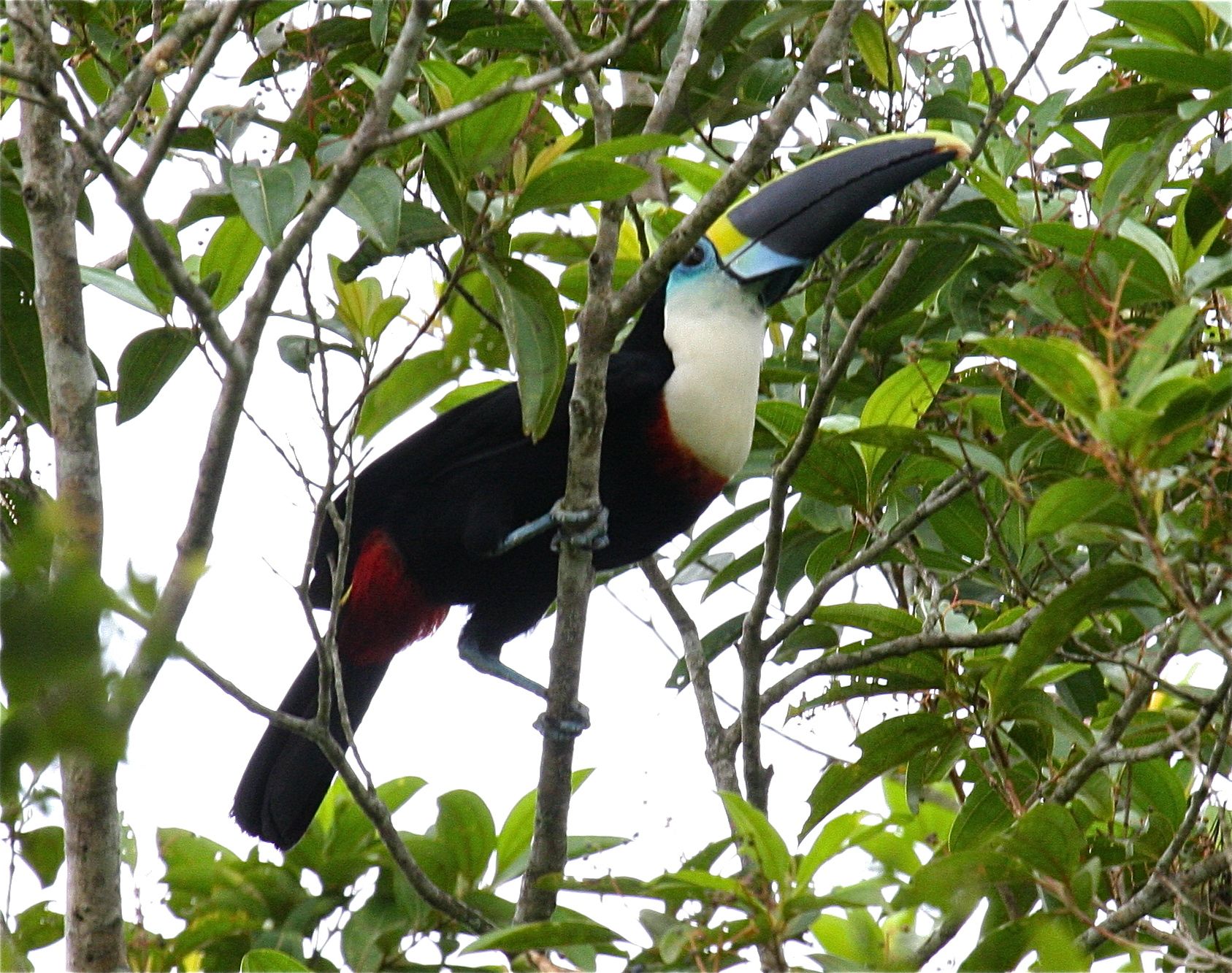
Ramphastos tucanus
TAXONOMY
Ramphastos tucanus Linnaeus, 1758. The genus Ramphastos is
made up of 11 species, the largest members of the toucan family.
The clade is most closely allied to the mountain toucans
(Andigena).
OTHER COMMON NAMES
English: Red-billed toucan, Cuvier’s toucan; French: Toucan
de Cuvier; German: Weissbrusttukan; Spanish: Tucan Goliblanco.
PHYSICAL CHARACTERISTICS
Length about 24 in (55 cm); weight about 21.8–24.8 oz
(618–702 g) male; 19.4–24.2 oz (551–687 g) female. A large
bird, jet-black from the top of the head down the nape and
back to the rump. White at the throat, as the name indicates,
with narrow red breast band; below that, black belly and
thighs. Yellow uppertail-coverts and red undertail-coverts set
off the black tail. The ring of bare skin around the eye is blue;
the bill is mostly red (subspecies tucanus) or black (subspecies
cuvieri) with a narrow yellow stripe along keel of upper bill;
base of bill is yellow on top and blue on bottom.
DISTRIBUTION
Primarily Amazonian in
DISTRIBUTION
, ranging from Colombia
and eastern Venezuela through Bolivia and Brazil. Often occurs
in the same areas as the similar-looking (though smaller)
channel-billed toucan.
HABITAT
Occupies tropical lowland Amazonian forest almost exclusively,
ranging up to 3,600 ft (1,100 m). Also seen in second-growth
forest, edge habitat and clearings, and around towns and cities.
BEHAVIOR
A conspicuous, large toucan that typically perches on dead
branches above the forest canopy. The yelping call—considered
the characteristic bird call of the Amazon—is said to resemble
a puppy’s barking; it begins with a sharp, descending,
whining note that is followed by two to four additional monosyllabic
pitches. Birds usually travel in pairs or small family
groups of up to six birds, although larger flocks are sometimes
seen. Aggressive and dominant in interactions with other
species at fruit trees. Flockmates seem to engage in play, including
bill-fencing, tag, and pass-the-fruit.
FEEDING ECOLOGY AND DIET
Not well known but eats a variety of fruits plus insects and
lizards and takes eggs and nestlings from a variety of passerines.
An active bird when feeding, often plucks fruit with tip of
bill, then tosses head so fruit falls backward into mouth. Wipes
bill on tree branch afterward, or scrapes bill with foot. To
drink, turns bill sideways and swipes across surface of water,
then lifts bill up and tilts head back.
REPRODUCTIVE BIOLOGY
Courtship
BEHAVIOR
s include bill-nibbling, allopreening, and
courtship feeding. The breeding season varies with location.
Nests are constructed in natural tree cavities, 3–60 ft (1–18 m)
off the ground; birds often re-use cavities where they have
nested successfully in the past. The two to three white eggs are
elliptical in shape; the parents share incubation duties and the
eggs hatch after about 15 days. Both parents feed the young,
which open their eyes after 29 days and fledge after about 49
days. Capuchin monkeys are a threat to toucan eggs and
young.
CONSERVATION STATUS
Not threatened.
SIGNIFICANCE TO HUMANS
Hunted by Native Americans for food.
Other popular Animals
Photo Gallery of - White-throated toucan




 Animalia Life
Animalia Life